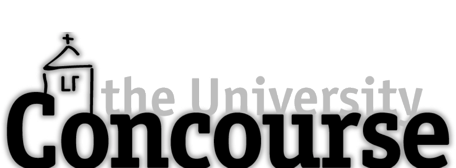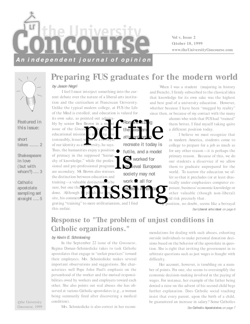Dancing for God
by Kay Cummins
As a ballet dancer and former student at Franciscan University who was moved and led to deeper prayer by the humility, grace, and love for God shown in the dancers’ movements, I was saddened by the recent article “Dance has no place in liturgical context.” I was saddened by the lack of appreciation of the beauty of dance and the lack of understanding of the experience of the congregation lifted up in worship through the movements of the dancers.
The emphasis is not on the body but the act and movements of worship appealing to the senses in a natural and concrete way. In Tchaikovsky’s Swan Lake the dancers are performing a dance which is a story. Like the artist’s paint and brushes, the singer’s voice, and the author’s words, the dancer’s body is merely the tool. The body itself is not the focus; although the agility, grace and control are inspiring, they are not the end.
We are called to love God not just in the silence of our minds and hearts (though that is where love is inflamed and the Divine Lover meets us) but also in our actions and movements in service of those who surround us. The movement of the dancer is a metaphor of this reality. Her movement and expression of love for God encourages us to define ourselves and our lives toward concrete and real action for God and His Kingdom.
As to its place in the liturgy, dance should never compete with the Holy Eucharist, which is the saving act of divine history. Liturgical movement, like music which unites the Body of Christ in the celebration of the liturgy, is important, vital and dynamic in leading the congregation to a fuller participation. Franciscan University has a place within the Church in providing and celebrating the Mass in a vibrant, holy and respectful manner.
There is much movement already present in the liturgy: we sit, stand, genuflect, kneel, bow, process or walk forward to receive Holy Communion. These concrete acts which we engage in as a body unify and lead us to understand that our faith is and should be an active faith. Liturgical movement which underscores the inherent movement already in the liturgy plays an important role in leading the congregation to a deeper experience of the liturgy and of worship.
A good example of this is in the procession and the standing of the Body of Christ in preparation for the reading of the holy Gospel. Arm movements (by the body) lifted up to heaven as a sign of our longing to hear God’s Word and to receive Jesus (Come, Lord Jesus!) are powerful and appropriate. This is a concrete act which gives form to the feelings and desires of the heart, which the Church intends. The movements evoke an openness, a longing for Christ, simply and effectively.
Is there a time when liturgical dance is not appropriate? Yes, when it detracts from the flow of the Mass. Like a musical piece or musical solo after communion, a liturgical dance that does not include or involve the participation of the congregation is inappropriate in the liturgy. Any art form—music or dance——which draws attention to itself (regardless of how beautiful it is) and does not involve the congregation, is not acceptable because it is not a communal act. The liturgy is primarily a communal act that reaches a climax in the sacrament of the Eucharist or Holy Communion. Mass is not a time to be entertained but rather a time to express (as one Body) our love for God in worship and prayer. However, a formal dance which tells a story, such as a meditation on Mary’s life or on St. Francis consumed with joy, in which the whole Body cannot participate, should and can take place before the Mass as a form of preparation for what is about to occur. As a prelude like organ music, liturgical dance prepares us for the act of worship and focuses us on what is to come.
We are creatures and we learn not only through our minds but our senses and our hearts as well. The beauty of a flower, its scent, its form, its color, raises our minds and souls to the Creator, the Author of the flower. So too, the actions of the dancer’s body in a prayerful and meditative manner lift the mind and soul to the Creator, the Author.
Freedom in movement, the vivacity and spontaneity, bespeak the ecstasy the soul experiences in having encountered the most profound reality the human can and ever will know—Jesus Christ. We have been set free and all that we are and can be is realized in Him. Does this not move the heart to express with movement and expression the profound love it feels, as David did before the Ark of the Covenant?
Kay (O’Meara) Cummins ‘88 is married to Dan, a professional tennis instructor and a graduate student in philosophy at the University of Dallas. She is also the mother of two young children and lives in Dallas, TX.


